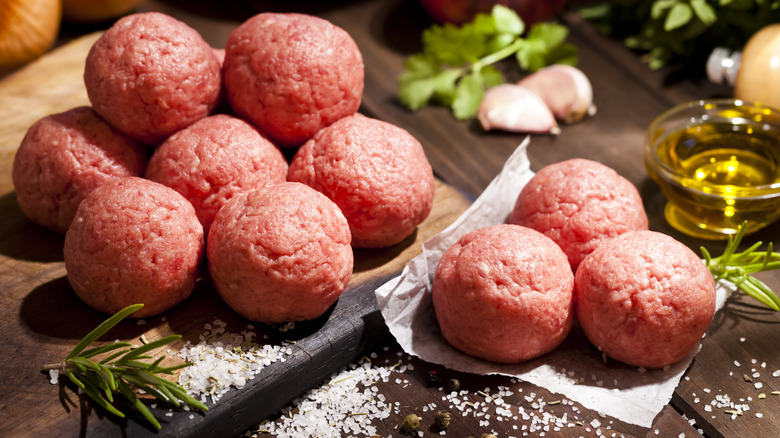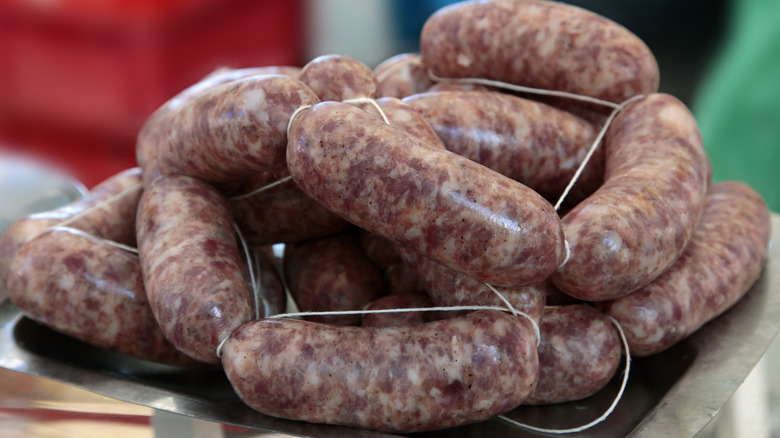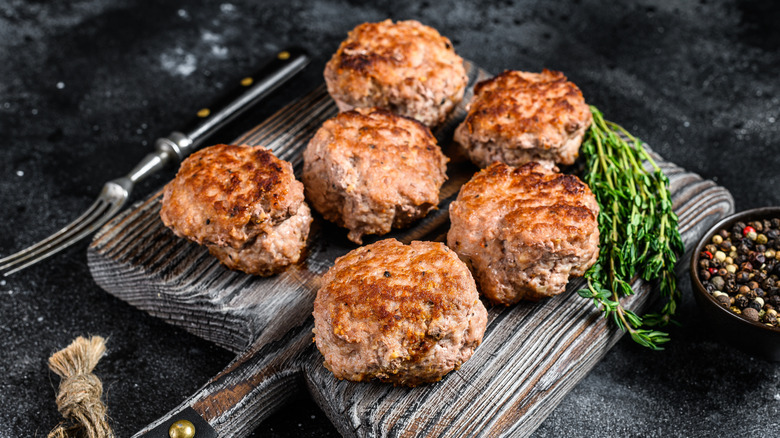Give Flavor To Pork-Free Meatballs With A Key Seasoning
Many of the best meatball recipes, from Italian grandmothers to celebrity chefs like Bobby Flay and Ina Garten, use a combination of beef, pork, and veal to enhance the flavor of their meatballs. Shockingly, America's dominant Italian restaurant chain Olive Garden, according to its Pork and Alcohol Menu Information, has no pork in its meatballs. No one would stand to defend the "authentic-ness" of Olive Garden's cuisine, but its meatballs certainly pass the smell (and taste) test.
The secret is Italian seasoning. This dried herb combination consists of oregano, thyme, basil, rosemary, and marjoram. Depending on the brand, it may also include sage, fennel, garlic, or red pepper flakes. This pre-packaged seasoning works like a greatest hits tour of Italian tastes, evoking all the flavors that are expected in the iconic dishes of the country.
Using a seasoning to replace the flavor of the meat isn't going to work most of the time, but in this case, it does. This is thanks to a long-standing Italian food taste tradition.
Italian pork sausage is chock full of traditional Italian herbs
The best Italian sausages are going to include some or all of the following ingredients: salt, pepper, basil, oregano, and fennel. There are homemade recipes out there that also include marjoram, garlic, thyme, or anise seed. These flavors are essential and, not surprisingly, have a lot of overlap with Italian seasoning.
These ingredients are so important, in fact, that they are intrinsic to the taste of Italian sausage and pork. A single bite of a well-made sausage and pepper hero delivers on those herb flavors so well that, if they were missing, it would be instantly noticeable. That is why including Italian seasoning in pork-free meatballs works so well. The seasoning engages a sense memory of the traditional Italian sausage so much so that a pork-free meatball will provide a pork-full experience.
This is great for gourmands who have dietary restrictions that prohibit pork; they get all the flavor and none of the pig. And a regular beef meatball, when seasoned and cooked well, will more than suffice in most situations.
There are several other ways to obtain flavorful meatballs
The best meatballs have a slightly crispy outside and a soft, melt-in-your-mouth center. One of the more disappointing things that can happen is biting into a meatball, and it has the texture of sawdust. There are several ways to combat this dryness that also add a burst of flavor.
The most obvious way to maintain flavor and moistness is through the addition of fats. The fats in ground beef are a major part of the meat's flavor. According to the USDA, ground beef has a fat content limit of 30% — but most grocery stores will cap their fat content at 20%. That's plenty of fat for a tasty meatball.
An alternate fat source can come from dairy. The addition of Parmigiano Reggiano or Pecorino Romano cheese can provide significant flavor and moistness. When the cheese melts, the moisture and fats in it are released directly into the meatball, staying encased in the center after it has been cooked. The same effect is achieved with the addition of milk which, when combined with Italian-style breadcrumbs, also acts as a binding agent for meatballs. For those who can't mix meat and dairy, try adding egg — it works both as a binder, but it all adds a bit of oomph and fat.
While the addition of pork adds a lot to a meatball's flavor, replacing it with an alternate fat source means that Sunday family dinners will still taste just as good as the ones Grandma used to make.



